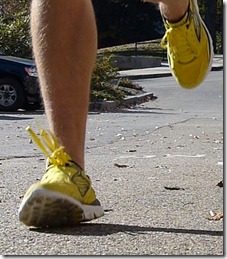 I spent some time this afternoon with a group of my research students who are designing a senior project that they’ll hopefully conduct on running form. The goal for today was to familiarize them with the cameras that I have, and get some video from different angles so they have an idea of what they can potentially work with. For me it was a chance to play with my new HD slow motion camera (Panasonic FZ200) – I got some great footage shot in HD 720p at 120 frames-per-second – I’m loving this camera for outdoor footage, but have not tried it inside yet.
I spent some time this afternoon with a group of my research students who are designing a senior project that they’ll hopefully conduct on running form. The goal for today was to familiarize them with the cameras that I have, and get some video from different angles so they have an idea of what they can potentially work with. For me it was a chance to play with my new HD slow motion camera (Panasonic FZ200) – I got some great footage shot in HD 720p at 120 frames-per-second – I’m loving this camera for outdoor footage, but have not tried it inside yet.
I thought I’d share a few clips of me running (slowly) from behind in three different conditions: barefoot, in Newton Distance Racers, and in Skechers GoRun shoes. We shot the video from waist down since we were mainly just playing around and they will probably be focusing on the feet in whatever project they choose to pursue. There was no warm-up, I ran from about 20 feet behind and to the side of the camera to maybe 100 feet beyond the camera, so I had to cut inward a bit to get in line with the camera view. Every time I do this I realize how horrifically difficult it is to run fluidly and relaxed when you know you are being filmed!
I’ll refrain from commenting on myself beyond saying that I see forefoot strikes when barefoot and mild heel to midfoot in shoes, but if you’d like to tear apart other aspects of my form, feel free to do so in the comments!
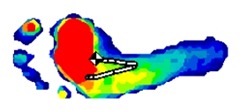
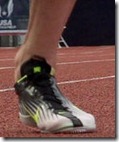
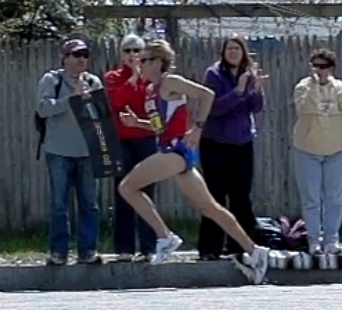
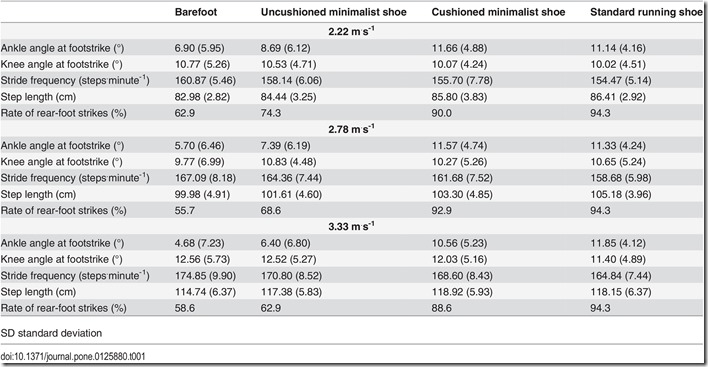














Appears that some crazy ankle movement is going on when wearing shoes. That can’t be good for very long.
My first impression is that the shoes are “stabilizing” his feet and causing that twisting motion. Makes me interested in rounded shoes (side to side), maybe particularly a pod under the heel and the ball of the foot to minimize that corrective motion.
“Crazy ankle movement?” Meh, I see some pronation, but nothing worrying. Some pronation is normal upon impact to absorb force…same as hip or knee flexion. There’s a little bit more rearfoot eversion with the Newtons, particularly on the right, but nothing that I’d really see as all that worrying. It looks like there may be some slight variance in velocity, which makes it hard to analyze against each other, but honestly, something just looks “snappier” about his gait in the Sketchers than in the Newtons or barefoot. Just looks natural. Pete, if your students happen to measure stance time as a percentage with each shoe, would you be willing to post?
Definitely have some heel strikes there. Makes me want to go out and film myself!
I tend toward mild heel to midfoot in cushioned shoes, but dramatically less heel than a few years ago. I used to tear up heels of my shoes, not so much anymore.
Continuing to shift your body weight off the heel as you run would be my advice :-)
In the Newtons it looked like more heel on right foot than the left….
To begin with you should film this on a flat surface. You have said in the past (correct me if I am wrong) that running form is not just about the feet, so why bother doing senior research and only look at that?? I doubt it would even get past your own critque. I realise you were “just playing” with the camera – but do you expect to get decent comments on such? Hard to be accurate with it, but barefoot stride length looks shorter, and perhaps slower paced.
It was a flat surface. And research projects ask specific questions, big difference from a global form evaluation. If the interest is in understanding how shoes influence foot contact, you look at the foot.
I’ll add that undergraduate projects are as much designed to get the students experience in designing a project and carrying out the work as they are designed at producing publishable results (i.e., learning research methodology). Sometimes a group of students pulls together something great, and that’s the fun part of this job.
I should also point out that it’s really hard to objectively analyze global form on a large sample outside of a lab (e.g., you can’t put markers on runners in a race), and my preference is to film runners in a more “real-world” setting.
—-
Pete Larson’s Web Links:
My book: Tread Lightly – link to ow.ly
Blog: https://runblogger.com
Twitter: link to twitter.com
Facebook: link to facebook.com…
I wonder if it is possible that what looks on camera like a (mild) heelstrike, is in fact a midfoot or forefootstrike when you would measure the pressure / weight distribution on the sole of the shoe. Just because the back of the shoe first touches the ground doesn’t have to say everything. It would complicate research, though.
It may also be that my foot is oriented the same way in all three conditions and the heel simply gets in the way and makes first contact. My sensation is that I don’t load through the heel, so you may be right, but point of first contact can influence how the foot is torqued.
And a classic crossover gait if I’m not mistaking, looks like you’re running on the invisible line from my point of view.
I’m not an expert at all, but to me it looks better when running barefoot.
I should film myself too… it’s interesting.
Why only look at your feet?? – they only land as a consequence of what your overall body position is. So, in my opinion as a running technique coach, this is inconclusive!!
I agree, but if you are simply comparing the effects of footwear on how the foot contacts the ground then focusing in on one area is ok in my opinion. There’s a difference between a global form evaluation done by a coach or therapist and an experiment designed to address a specific question.
i guess you’re running on a descent street, so it’s “natural” a heel strike
No, it’s flat ground, but I’m not all that concerned about the foot strike. My opinion is a bit to either side of the midfoot is probably no big deal if everything else is good.
—-
Pete Larson’s Web Links:
My book: Tread Lightly – link to ow.ly
Blog: https://runblogger.com
Twitter: link to twitter.com
Facebook: link to facebook.com…
The problem with shoes is that the sole extends below and lateral to the margin of the foot, so you increase the lever arm of the GRF at initial contact, which torques the foot inward rapidly. The stiffer the shoe, the thicker the sole, and the wider the lateral flare sole below the foot, the greater the torque. Personally, I generally like shoes where the sole is thin but cushioned and closely matches the outline of the foot – racing flats often do a good job of this.
—-
Pete Larson’s Web Links:
My book: Tread Lightly – link to ow.ly
Blog: https://runblogger.com
Twitter: link to twitter.com
Facebook: link to facebook.com…
I don’t really see heel striking. Looks to me like you bring your toe down just before you strike and touch down pretty much with your whole foot. You can see that more clearly when you’re barefoot. Obviously, there’s the torquing when shod, which looks nasty in slow motion!
BTW, any plans on trying to improve your 10k pb? Considering your other times, seems there’s room for improvement.
Yes! Just really hard to find a 10K around where I live. That was one of the first races I ran :)
—-
Pete Larson’s Web Links:
My book: Tread Lightly – link to ow.ly
Blog: https://runblogger.com
Twitter: link to twitter.com
Facebook: link to facebook.com…
Pete, what struck me as interesting was not just the foot strike but the rotation that takes place when you are at the top of the back kick. The ankle motion is pretty evident in all three and after the initial plant it looks as though you pronate through naturally.
At foot strike though, your toes are pointed slightly out. This might be the source of the initial torque especially in the Newtons with the bigger heel. It looks as though your lower leg rotates slightly and you are crossing over on your gait. This was less noticeable when you were barefoot.
I see this sort of motion with the kids that I work with who are growing and the muscles and connective tissue are all very tight. (An aside, my daughter grew 8 inches in 6 months – it took two years for her to get squared away again.) If you spend a fair amount of time sitting, I would suggest you look at hip flexibility.
It would be interesting to chart where your knees and ankles track in various shoes to see if the shoes themselves are knocking you slightly off balance.
I am very tight, and the left foot tends to rotate a bit more I think – I have a noticeable shoe wear asymmetry with left foot wearing a bit more back toward the heel. Has been that way since I started running. I need to keep at flexibility work!
The Newton’s looked more heal than the GoRuns. Are the GoRuns a zero drop shoe?
Steve – GoRuns have an unusual sole – rockered with a bump under the midfoot and an undercut heel. Very hard to land on the back of the heel in them, which you can tell by how white the sole still is in that area.
Ignoring foot strike for a moment, when your foot kicks back you seem to rotate the toe-end of your foot outward when your foot is at its peak height above the ground. Is that good, bad, or immaterial? Perhaps it is just preparation for landing the lateral edge of the foot first? It seems pretty pronounced in all of the videos once you turn your attention away from the ground strike.
Oops, longrunningfool already pointed that out — not sure how I missed that post.
The only way to get a feel of what form in slow motion should look like, is by watching lots of form in slow motion from accomplished runners. Probably nobody here has ever done that. So any comment we can make would just be projecting our own, almost certainly wrong, preconceptions. And I think the comments thread sort of shows that.
But this gives everyone a chance to see some of the variation out there and share thoughts, no harm in that.
—-
Pete Larson’s Web Links:
My book: Tread Lightly – link to ow.ly
Blog: https://runblogger.com
Twitter: link to twitter.com
Facebook: link to facebook.com…
Fascinating exploration of form. “my preference is to film runners in a more “real-world” setting.” — Right. I wonder to what degree, if any, form is affected by a person knowing that their form is being evaluated, you know? Like, would there be a difference in form if you were completely unaware of the recording, i.e., “in the zone.” Equally interesting would be to see the difference between the landing form of the same runner at different points in a long run — the first-mile form when working out the kinks vs. mid-run form when all cylinders are firing vs. near the end of the run when fatigue is rearing its ugly head.
ll good questions. I can say that I am very self conscious of my form when I am filming. When I film races, I try to be as unnoticeable s possible. As for fatigue, I have video of marathoners at miles 6 and 20. Published a paper on footstrikes on that data: link to ncbi.nlm.nih.gov…
—-
Pete Larson’s Web Links:
My book: Tread Lightly – link to ow.ly
Blog: https://runblogger.com
Twitter: link to twitter.com
Facebook: link to facebook.com…
at ~0:44 i’m in shoes and 1:38 i’m in just socks. the shoes are merrell trial gloves.
link to youtube.com…
Nice! Curious – what was your reason for switching form?
—-
Pete Larson’s Web Links:
My book: Tread Lightly – link to ow.ly
Blog: https://runblogger.com
Twitter: link to twitter.com
Facebook: link to facebook.com…
Hi Pete,I have been plaugued with calf pulls in my right leg for about 12 months I used to run at school many years ago and have been back running only two two and a half yearsmy first trainers were saucony jazz 13 no problems,I had a gait analisis done at a sports shop after buying asics 1150s I think,had itband issue within weeks.they told me I
was a neutral runner and recommended nike air pegasus 28s calf went within 8 weeks but didnt connect the two bought a pair of pegasus trail as was going off road and all seemed fine but still getting niggles in my right calf.
After a summer of not to bad running my problems returned and i visited a sports injury clinic,I had various tests in stance and muscle measurements but only when I got on the treadmill did he see the problems I have.
In barefoot my form was good no problems.
In nike air pegasus 28s trail serious ankle collapse more prominent in the right leg.
in a pair of adidas tempo 4s better but still not as good as barefoot and I have had my calf pull in these as well.
The guy reckoned that I was better in the addidas because they have a torsion control in the midfoot thus making them more rigid than the nikes.
I am now running barefoot on the treadmill building up time and thinking about moving into the barefoot style of shoes any thoughts or advice you may have would be greatly appreiciated.
Hi Jogon!,
Build slowly and progressively. If you take your time you’ll be rewarded by a better running form while avoiding injuries.
Also beware of some spots on treadmill’s belt where the temperature is rising because of friction with parts under the belt. When I was learning to barefoot on the treadmill, I was oftenly taking some 1 minutes pauses for avoiding this issue while drinking some water.
Hi Pete, what is your experience with wear on the ‘pods’ in the Skechers? I have been wearing the GoRun Rides for ~100 miles and some of the pods, especially in the middle of the forefoot, are pretty worn down. They still feel fine while running, but I’m concerned that the wear may cause an unhealthy gait.
I don’t have enough miles on a single pair to comment – being involved in the development of the shoe as a wear tester means I was always trying new pairs with minor tweaks. I’d say as long as you feel ok it’s probably not an issue, but if things start to feel off then time for a new shoe. Wear rate in a given shoe is pretty individual and is influenced by gait.
—-
Pete Larson’s Web Links:
My book: Tread Lightly – link to ow.ly
Blog: https://runblogger.com
Twitter: link to twitter.com
Facebook: link to facebook.com…
Hi Pete,
Looks like you’re stabilizing your foot more rapidly when you’re barefoot.
I think probably less effort needed to stabilize when barefoot since less torque of the foot at contact.
I seem to recall seeing a slow-motion video on Youtube of Haile Gebrselassie pronating just as much.
Just wondering–was your cadence around 180 bpm when filming?
Not sure on my cadence while filming, but it’s usually 182-184. Haile pronates a lot more than me :)
—-
Pete Larson’s Web Links:
My book: Tread Lightly – link to ow.ly
Blog: https://runblogger.com
Twitter: link to twitter.com
Facebook: link to facebook.com…
Yeah, I meant to say “as much as you, if not more.” So have you had many problems with injuries? It seems to me that as long as the cadence is quick enough, and one is generally running in a barefoot style, over-pronation is not a bad thing and will not necessarily lead to injury.
Very minor morning PF on an on and off basis, but really nothing that has ever kept me from running or interfered with my training.
—-
Pete Larson’s Web Links:
My book: Tread Lightly – link to ow.ly
Blog: https://runblogger.com
Twitter: link to twitter.com
Facebook: link to facebook.com…
Pete, here’s what I see:
You are landing hard, and the muscles that limit pronation are not doing their job because:
You are not getting good plantar flexion on leg extension.
This looks like it is due to what you are doing with your upper body. You aren’t extending your spine into a forward lean, and you aren’t allowing your weight to move forward until your toes flexors engage.
You are retracting and not moving your arms.
Note that your arms have no movement at the glenero-humoral joint, and thus, none at the sterno-clavicular joint. You are rotating your whole ribcage as a block, and not allowing your spine to have good, distributed spiral
movement. In free arm swing, we should see some movement at shoulders, sternum and through the 1st rib to the spine. The ribs should slide,
slinky-like.
If you could lead with your head and allow the weight of your arms to be of more use, you could begin to get better plantar flexion, which would:
1. Allow you to have a longer acceleration through extension, which would permit your leg to recover and reach the ground before your weight crashes down (what I see you are now doing), and
2. Get your toe flexors in better shape to help limit pronation.
A few Alexander Technique lessons could
help. Your problems are not running technique problems as much as they are postural problems..